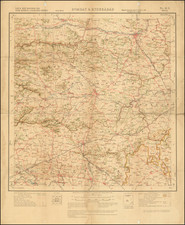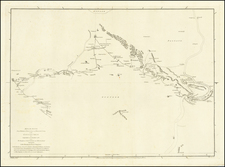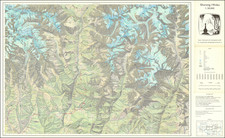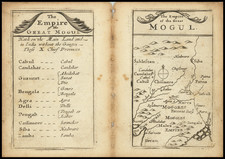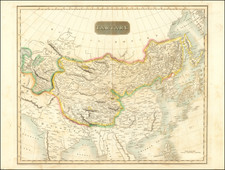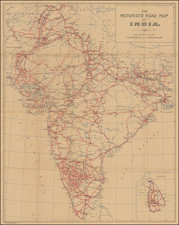Detailed French Manuscript Map on Linen Showing French and English areas in the Territory of Puducherry
Finely-executed manuscript map of the territory of Pondicherry, now known as Puducherry. The city, until 1954, was a French colonial outpost. This map shows the entirety of the territory of Puducherry, which radiates from the coastal city in a checkerboard pattern; it is loosely bounded on the east by the Bay of Bengal and on three sides by Tamil Nadu.
The map has many irregular polygons painted yellow. These are the French territories, while the lighter colored areas are under British control, as much of India was at the time the map was made. In the upper left, between the rivers Gingy and Chounambar, is a polygon with a purple outline. These are the Vadanour villages and there the French have only a 5/12 stake. The territory is thus a patchwork quilt showing the variable sovereignty of colonial India.
The areas of European and shared control are bisected by many roads, which are identified in the legend into first- and second-class routes. These routes are drawn from the maps and plans of the Ministère de la Marine, which houses France’s official mapping body. Mobility is clearly of the utmost importance to this area which depended on the movement of goods and peoples to sustain the agricultural economy.
The legend also identifies the many other details inked into the map, including locks, weirs, dams (both French and English), and canals. The many waterways and ponds (etang) again point to the fertility of the surrounding land. The main crops were rice, sugarcane, peanuts, and cotton, with most people living in small villages near their fields.
By far the largest settlement in the territory is the city of Pondicherry itself, here shown in a detailed plan. A canal bisects the city. Although it is not labeled here, these two areas were known as the Ville Blanche and the Ville Noire (White Town and Black Town). The Ville Blanche is sandwiched between the canal and coast, and was where the European residents, a minority in the city, lived separately from the indigenous Indians and other ethnic groups.
The map was drawn in Puducherry and finished on March 22, 1973. It was drawn by Emile Pochont, likely a colonial official or engineer employed by the French government.
Puducherry as a French possession in India
The French East India Company first established Puducherry as a factory or trading center on February 4, 1673, when Bellanger de la Espinary, a French officer, took up residence in the Danish Lodge, which was then a tiny fishing village. In 1674 François Martin, the first Governor, began transforming the town into a major port and, in time, it became the premier French settlement in India.
The development of the town made it an object of interest to many European overseas empires. The Dutch captured Puducherry in 1693 but returned it to France by the Treaty of Ryswick in 1699. In the eighteenth century, the French expanded their holdings on the Indian coastline, acquiring Mahe in the 1720s, Yanam in 1731, and Karaikal in 1738.
In 1748, the British led a failed siege on Puducherry; it was one of the first engagements in which Robert Clive saw action. The siege was the last of the major actions in the Indian theater of the War of Austrian Succession, a conflict also known as the First Carnatic War.
On January 16, 1761, the British captured Puducherry from the French and destroyed much of it; this map shows the rebuilt city. The rubble and land were returned to France in the Treaty of Paris (1763). The British took control of the area again in 1793 during the Wars of the French Revolution. They again returned the port and town to France in 1815. When the British gained control of the whole of India in the late 1850s, they allowed the French to retain their settlements in the country.
Pondicherry, Mahe, Yanam, Karaikal, and Chandernagar remained a part of French India until 1954. Today, the first four of those cities form the modern territory of Puducherry. This map, by contrast, shows the older territory of Puducherry, the most important French foothold in British India. Manuscript maps like this are rare survivals, especially one that shares so much information about the administration of territory as this map does.









